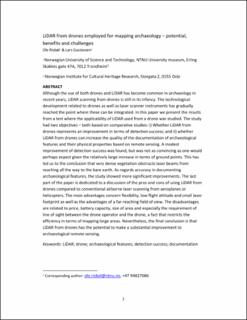| dc.contributor.author | Risbøl, Ole | |
| dc.contributor.author | Gustavsen, Lars | |
| dc.date.accessioned | 2021-04-08T09:10:41Z | |
| dc.date.available | 2021-04-08T09:10:41Z | |
| dc.date.created | 2018-06-29T19:14:53Z | |
| dc.date.issued | 2018 | |
| dc.identifier.citation | Archaeological Prospection. 2018, 25 329-338. | |
| dc.identifier.issn | 1075-2196 | |
| dc.identifier.uri | https://hdl.handle.net/11250/2736798 | |
| dc.description.abstract | Although the use of both drones and LiDAR (light detection and ranging) has become common in archaeology in recent years, LiDAR scanning from drones is still in its infancy. The technological development related to drones as well as laser scanner instruments has gradually reached the point where these can be integrated. In this paper we present the results from a test where the applicability of LiDAR used from a drone was studied. The study had two objectives – both based on comparative studies: (i) whether LiDAR from drones represents an improvement in terms of detection success; and (ii) whether LiDAR from drones can increase the quality of the documentation of archaeological features and their physical properties based on remote sensing. A modest improvement of detection success was found, but was not as convincing as one would perhaps expect given the relatively large increase in terms of ground points. This has led us to the conclusion that very dense vegetation obstructs laser beams from reaching all the way to the bare earth. As regards accuracy in documenting archaeological features, the study showed more significant improvements. The last part of the paper is dedicated to a discussion of the pros and cons of using LiDAR from drones compared to conventional airborne laser scanning from aeroplanes or helicopters. The main advantages concern flexibility, low flight altitude and small laser footprint as well as the advantages of a far‐reaching field of view. The disadvantages are related to price, battery capacity, size of area and especially the requirement of line of sight between the drone operator and the drone, a fact that restricts the efficiency in terms of mapping large areas. Nevertheless, the final conclusion is that LiDAR from drones has the potential to make a substantial improvement to archaeological remote sensing. | |
| dc.language.iso | eng | |
| dc.relation.uri | https://onlinelibrary.wiley.com/doi/full/10.1002/arp.1712 | |
| dc.subject | Drone | |
| dc.subject | Lidar | |
| dc.title | LiDAR from drones employed for mapping archaeology – Potential, benefits and challenges | |
| dc.type | Peer reviewed | |
| dc.type | Journal article | |
| dc.description.version | submittedVersion | |
| dc.subject.nsi | VDP::Annen arkeologi: 099 | |
| dc.subject.nsi | VDP::Other subjects within archaeology: 099 | |
| dc.source.pagenumber | 329-338 | |
| dc.source.volume | 25 | |
| dc.source.journal | Archaeological Prospection | |
| dc.identifier.doi | https://doi.org/10.1002/arp.1712 | |
| dc.identifier.cristin | 1594911 | |
| cristin.unitcode | 7530,52,0,0 | |
| cristin.unitname | Avdeling for Digital dokumentasjon, kulturminner og landskap | |
| cristin.ispublished | true | |
| cristin.fulltext | preprint | |
| cristin.qualitycode | 1 | |
